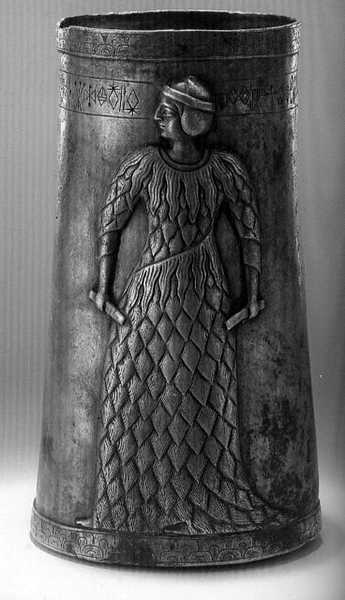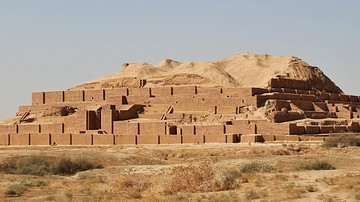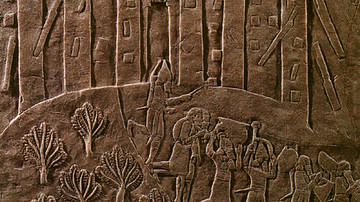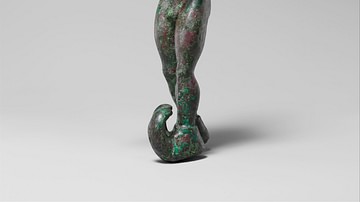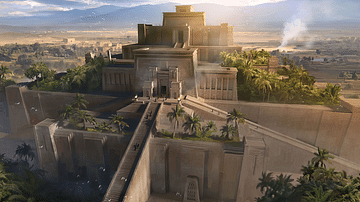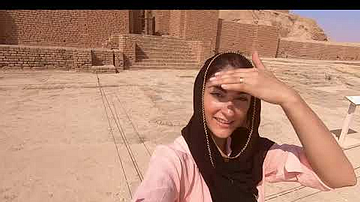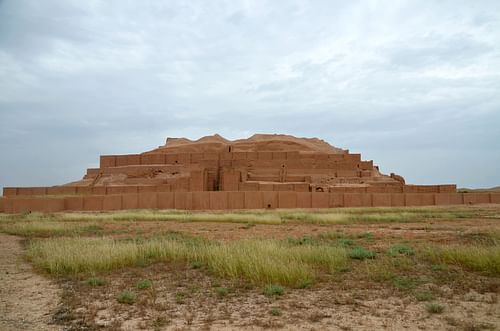
Chogha Zanbil (literally “basket mound”) is an ancient Elamite temple complex located in the modern-day province of Khuzestan, Iran. It is also known as Dur-Untash (Fortress/City/Town of Untash), Tchogha Zanbil, and Al Untash Napirisha (“Place of Untash Napirisha”) and features the largest ziggurat in the world outside of Mesopotamia and the best preserved.
It was built c. 1250 BCE during the Middle Elamite Period (c. 1500 - c. 1100 BCE) by the Elamite king Untash-Napirisha (r. c 1275-1240 BCE) and dedicated to the Elamite gods Insushinak and Napirisha but also included shrines to other gods, many of Mesopotamian origin, in order to provide the diverse population of Elam with an all-inclusive center of worship.
Untash-Napirisha originally dedicated the site solely to Insushinak, the patron deity of nearby Susa, and it is thought he intended to draw attention away from Susa as one of the royal cities of Elam and establish his new city as a capital. He changed his mind, however, possibly after considering the wide array of religious traditions and diverse gods followed by the people of Elam, had the original ziggurat dedicated to Insushinak torn down, and built a much grander complex with a larger ziggurat, temples, and shrines, and housing for priests all enclosed behind three massive concentric walls.
The temple complex was never used, however, as it was incomplete at the time of the king's death and abandoned sometime afterwards. Archaeological finds at the site give evidence that it continued as a pilgrimage site up through 1000 BCE, but the complex was never completed as is made clear by mud bricks still stacked for use in construction and unfinished temples at the site.
The complex was sacked by the Assyrian king Ashurbanipal (r. 668-627 BCE) when he invaded Elam in 647-646 BCE but, contrary to his boasts and the claims of later historians, he did not destroy the site. After c. 1000 BCE, Chogha Zanbil was forgotten until it was rediscovered in 1935. To fully appreciate the significance of the site, one must understand the culture of Elam which produced it.
Elam
Elam was a region with a diverse population, who were most likely indigenous, stretching from the Zagros Mountains in the north across the Iranian Plateau southwards, corresponding roughly to the modern-day provinces of Ilam and Khuzestan in southern Iran and part of southern Iraq. It was never a cohesive polity except for the brief period of the Elamite Empire founded in the Middle Elamite Period by the king Shutruk-Nakhkunte (r. 1184-1155 BCE) who chose the city of Susa as his capital.
Aside from the period of the empire (which did not last long beyond the reign of Shutruk-Nakhkunte's youngest son), the region was a federation of tribes ruled, at different times and with varying authority, by the cities of Awan/Anshan, Shimashki, and Susa. The history of the region is divided by modern-day scholars into four periods:
- Proto-Elamite Period (c. 3200 - c. 2700 BCE)
- Old Elamite Period (c. 2700 - c. 1600 BCE)
- Middle Elamite Period (c. 1500 - c. 1100 BCE)
- Neo-Elamite Period (c. 1100 - c. 539 BCE)
Of these four, the Middle Elamite Period is the best-documented. Elamite is a language isolate, meaning it corresponds to no other known language, and so Elamite script, in use throughout the Proto-Elamite Period, has yet to be deciphered. After 2700 BCE, and closer contact with the Mesopotamian city-states of Sumer, the Elamites adopted cuneiform script for their language and their history comes into somewhat clearer focus. Even so, their cuneiform inscriptions and documents (found primarily at Susa) are incomplete and so a large swath of Elamite history is only known from Sumerian, Akkadian, and Assyrian records which often give brief descriptions without elaboration.
During the Old Elamite Period, the region was conquered by the Sumerian king Enemebaragesi of Kish in 2700 BCE in the first recorded war in history which introduced cuneiform to Elam. The Akkadians under Sargon of Akkad (r. 2334-2279 BCE) next took Elam and held it until the Akkadian Empire fell to the invading Gutians who were driven out by the Sumerian king Ur-Nammu (r. 2047-2030 BCE) and his son Shulgi of Ur (r. 2029-1982 BCE) who then established Sumerian rule in Elam.
It was not until nearly the end of this period that the Elamite kings were able to assert their autonomy, defeat the Sumerians, and establish themselves as a significant power in the region. The kings of the Sukkalmah Dynasty of Elam (c. 1970 - c. 1770 BCE) provided the stability that would allow the rulers of the next period to concentrate more on domestic policies and building projects than defense of their homeland from invasion.
Middle Elamite Period
As noted, Elam's population was diverse, held together by a common language but apparently differing in customs and religious beliefs or, at least, which gods of the Elamite-Mesopotamian pantheon they chose to elevate. During the Middle Elamite Period, the kings of Anshan and Susa implemented a policy designated “elamization” by modern scholars by which they encouraged the adoption of Elamite beliefs, language, customs, and religion across the region but, especially, in the area of Susiana to the north where Mesopotamian influences had been widely embraced.
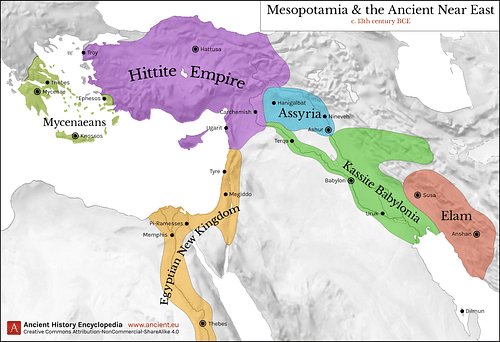
There is no evidence of coercion or violence of any kind in this elamization of the region and one of its benefits is more extensive documentation of the period as Elamite kings issued more decrees. The period was dominated by three dynasties:
- Kidinuid Dynasty (c. 1500 - c. 1400 BCE)
- Igihalkid Dynasty (c. 1400 - c. 1200 BCE)
- Sutrukid Dynasty (c. 1200 - c. 1100 BCE)
The Kidinuid Dynasty began the process of elamization, the Igihalkid Dynasty continued it, and the Sutrukid Dynasty spread Elamite culture throughout the region and across the region of Babylonia through the conquest which would establish the Elamite Empire. Interestingly, there is no evidence that Shutruk-Nakhkunte or his sons imposed their religion on any other region. If they had, there might be more documentation on Elamite religious beliefs but, as it is, little is known of the Elamite religion beyond the names of some of their many gods and what kinds of sites they chose for their rituals.
Elamite Religion
How the indigenous Elamite religion was practiced during the Proto-Elamite Period is unknown and, even if the Elamite linear script were deciphered, there is no guarantee it would shed any light on this aspect of Elamite culture. By the time Elamite inscriptions relating to the gods were set down, the region had already been influenced by Sumerian and Akkadian culture and religion. Throughout the Old Elamite Period, therefore, Elamite deities are referenced in conjunction with Mesopotamian gods and goddesses.
The Elamites established sacred sites on high hills, mountain tops, sacred groves, and in caves. Based on inscriptions, seals, and impressions, they approached these sites in a procession and offered sacrifices, but nothing is known of the details of religious rituals beyond this. There were over 200 deities in the Elamite pantheon, many of them Mesopotamian (such as Ea, Enki, Inanna, Ninhursag, Nisaba, Shamash, Erra, and Nergal) while the Elamite deities corresponded to the geographical region in which they had developed and risen to prominence from there. Ten of the most influential Elamite deities were:
- Napirisha – Lord of the Earth and the people
- Insushinak – Lord of Susa, judge of the dead, protector of the weak
- Humban – Lord of Anshan, guardian of the king (and royal family), sky god
- Kiririsha – Wife and consort of both Insushinak and Humban, mother of the gods, a mother goddess
- Pinikir – Queen of heaven, goddess of the sky
- Nahhunte – Lord of justice, god of fair trade and contracts
- Simut – God of Elam and all Elamites
- Narundi – Goddess of victory
- Ismekarab – Goddess of the underworld, hearer/protector of oaths
- Lamagal – (also given as Lakamar) Goddess of the dead and judge of souls
Napirisha, who seems to have originated around Anshan, eventually came to be regarded as the chief of the gods, the national god of Elam, recognized at all points. Insushinak was originally a god of the northern region of Susiana and, although he remained the patron deity of Susa, he was venerated in other areas as well. Humban followed this same paradigm only with Anshan as his city to the south. Initially, based on statuary and impressions, it seems the Elamites worshipped a mother goddess – perhaps even a triad of female deities – who most likely were combined in the figure of Kiririsha who is often associated with Insushinak and Humban but is also depicted as the consort/wife of Napirisha.
The focus of the religion seems to have been the afterlife. Prayers and sacrifices were made for an easy passage between this life and the next but the details of the Elamite vision of life after death are unknown. It is likely, given their close association with Mesopotamia, that their afterlife would have mirrored that of the Sumerians in which the souls of the dead languished in a dim, shadow world presided over by a female deity (in the Mesopotamian vision, Ereshkigal) who made sure the dead remained where they were and did not trouble the living.
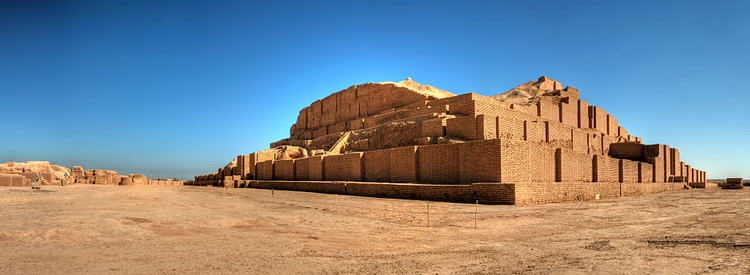
However they envisioned the afterlife, and whatever they believed their gods could do for them in assuring them of safe passage, one aspect of their religious devotion (common to all ancient cultures) was monumental building projects which would preserve their name, associate that name with their deity of choice, and thereby ensure that they would be remembered by future generations; this was the inspiration behind the construction of the temple complex of Chogha Zanbil.
Chogha Zanbil
Chogha Zanbil began as a ziggurat and surrounding courtyard dedicated to Insushinak. A baked clay brick, provenance unknown but thought to have come from the site, reads:
I, Untash-Napirisha, son of Humban-Numena, king of Anshan and Susa, desirous that my life be one of prosperity, that the extinction of my lineage not be granted when it shall be judged, with this intention I built a temple of baked bricks, a high temple of glazed bricks; I gave it to the god Insushinak of the Sacred Precinct. I raised a ziggurat. May the work which I created, as an offering, be agreeable to Insushinak! (Jones, 1)
Untash-Napirisha first dedicated the monument only to Insushinak in order to draw worshippers (as well as commerce and prestige) away from Susa, the god's patron city, to his own in which the Insushinak ziggurat would be the centerpiece (as per the model of Mesopotamian cities). At some point, after having finished or nearly finished the ziggurat, he had it torn down and embarked on a different course of a much grander vision: a temple complex honoring all the gods of the region to which anyone could come and pay homage to their deity of choice.
![Chogha Zanbil Ziggurat [East Side], Iran](https://www.worldhistory.org/img/r/p/500x600/10670.jpg?v=1702536009)
The ziggurat was now dedicated to Napirisha and Insushinak, thereby honoring all of Elam through the two most prominent gods of the south and north but also, in choosing Napirisha over, say, Humban, creating an all-inclusive center for the chief of the gods who presided over not only all the other deities of Elam but all of its people. It was an ambitious undertaking, as described by scholar Marc Van de Mieroop:
The construction was truly monumental: it contained millions of bricks, a substantial part of which was baked at great expense of fuel. The inner core of sun-dried brick was encased in a 2-meter-thick layer of baked brick. Every tenth layer of the outer casing had a row of bricks inscribed with a dedication from Untash-Napirisha to Insushinak. Because of the solidity of its construction, this is the best-preserved ziggurat in the Near east. Many of the temples in the inner enclosure were devoted to purely Elamite deities, while some of the others honored Mesopotamian gods popular in Susa. There was thus an increased attention to Elamite traditions. (186)
Construction began at the center with the ziggurat which, when completed, rose 174 feet (53 meters) high with a temple at its top (symbolizing the sacred sites of mountain tops) and at the bottom (representing sacred caves). After the ziggurat, the temples, shrines, and houses for the priests were built in an area of around 100 hectares which was enclosed by a concentric wall two miles (4 km) long which was then ringed by two others.
There was a royal entrance into a courtyard and, to the right of the entrance, were four temples dedicated to Elamite deities, among them, Pinikir (Queen of Heaven). The temple at the top of the ziggurat was dedicated to Insushinak and Napirisha; the temple at the base honored Kiririsha and there were shrines to her and the other gods to either side.
Two large buildings, designated “palaces” by the original excavators, were located in the so-called “royal quarter” which had subterranean chambers designed as burial vaults. Although only one skeleton was found in this tomb, it seems to have been created to house the remains of the entire royal family. Who the skeleton once was, or why others were not buried there, is unknown.
The palaces were ornamented, as was the ziggurat, temples, and shrines, with precious gems, statues of winged griffins, and other iconography honoring the gods. Even in its unfinished state, the complex would have been impressive, rising – as it did in its time – from a high, grassy plain with a forest below.
Construction was still underway when Untash-Napirisha died (cause unknown), and work was abandoned. Although Shutruk-Nakhkunte took some of the bricks to Susa, the complex was never raided for building material (as was the case with so many ancient sites, most notably the city of Memphis in Egypt which was dismantled to build Cairo). Although Chogha Zanbil was abandoned shortly after Untash-Napirisha's death, it continued to serve as a place of pilgrimage until c. 1000 BCE, after which it was forgotten.
The Assyrian king Ashurbanipal sacked the site in 647-646 BCE (possibly as late as 640 BCE) but, contrary to his claims and those of later writers did not destroy it. Elam was claimed by the Assyrians after Ashurbanipal's conquest, passed to the Medes after the fall of the Neo-Assyrian Empire in 612 BCE, and was finally absorbed into the Persian Achaemenid Empire (c. 550-330 BCE) c. 539 BCE. By that time, the great complex of Dur Untash was not even a memory.
Conclusion
The site was rediscovered in 1935 when geologists in the region commissioned a program of aerial photography to identify oil fields. The photographers alerted a team of French archaeologists working at nearby Susa (where the baked, inscribed bricks from Dur Untash, taken by Shutruk-Nakhkunte, had been found) who arrived at the site and identified it as the ancient Dur Untash. Its modern name, Chogha Zanbil, dates to about this time as the shape of the complex was thought to resemble an upside-down woven basket.
The first excavations were initiated in 1946 but the most significant work at the site was done by the French archaeologist Roman Ghirshman (l. 1895-1979) between 1951-1962. Work was continued at the site afterwards by Iranian and international teams working to stabilize and preserve the ziggurat and surrounding walls. In 1979, Chogha Zanbil was declared a UNESCO World Heritage site and preservation efforts continue even with the social turmoil of the region. Visitors from around the world regularly came to the site until the outbreak of the Covid-19 pandemic in 2020 when tourism worldwide was interrupted. Even so, Chogha Zanbil is expected to draw visitors to the region again in the future as the site remains one of the most impressive ruins from antiquity, not only in the Near East but in the world.
